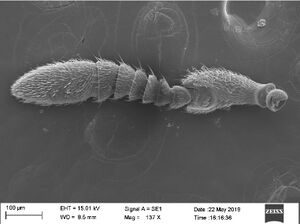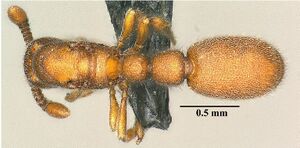Ooceraea octoantenna
| Ooceraea octoantenna | |
|---|---|

| |
| Scientific classification | |
| Kingdom: | Animalia |
| Phylum: | Arthropoda |
| Class: | Insecta |
| Order: | Hymenoptera |
| Family: | Formicidae |
| Subfamily: | Dorylinae |
| Genus: | Ooceraea |
| Species: | O. octoantenna |
| Binomial name | |
| Ooceraea octoantenna Zhou & Chen, 2020 | |
Nothing is known about the biology of Ooceraea octoantenna.
Identification
Distinguised from other Ooceraea by the following: 8-segmented antenna, eyes absent, posterior margin of head broadly V-shaped concave, the mesosoma dorsum almost straight, the promesonotal suture weak dorsally, the metanotal groove present but somewhat ambiguous.
Keys including this Species
Distribution
Distribution based on Regional Taxon Lists
Palaearctic Region: China (type locality).
Distribution based on AntMaps
Distribution based on AntWeb specimens
Check data from AntWeb
Countries Occupied
| Number of countries occupied by this species based on AntWiki Regional Taxon Lists. In general, fewer countries occupied indicates a narrower range, while more countries indicates a more widespread species. |

|
Biology
Castes
Worker

| |
| . | |
Queen
  
| |
| . | |
Nomenclature
The following information is derived from Barry Bolton's Online Catalogue of the Ants of the World.
- octoantenna. Ooceraea octoantenna Zhou & Chen, in Zhou, Chen & Chen, 2020: 140, figs. 1-7 (w.q.) CHINA (Guangxi).
- [Note: in the title of an early version of the publication the authors’ first and last names are reversed and appear as Shanyi, Z. (= Zhou, S.), Danni, C. (= Chen, D.) & Lin, C.Z. (= Chen, Z.L.).]
- Type-material: holotype worker, 9 paratype workers, 1 paratype queen.
- Type-locality: holotype China: Guangxi, Chongzuo City, Zuozhou Town, Pairu Village, 22°34.594’N, 107°25.311’E, 222 m., 10.vi.2016, no. G160045, subterranean (Z. Chen); paratypes with same data.
- Type-depositories: GNUC (holotype); GNUC, SFCY (paratypes).
- Distribution: China.
Unless otherwise noted the text for the remainder of this section is reported from the publication that includes the original description.
Description
Worker
Holotype: HL 0.55, HW 0.43, SL 0.26, MW 0.30, ML 0.61, PL 0.22, PH 0.35, PW 0.25, PPL 0.25, PPH 0.35, PPW 0.30, CI 78, SI 60, PI1 63, PI2 114, PPI1 71, PPI2 120, WI 120. Paratype wokers: HL 0.54–0.45, HW 0.41–.044, SL 0.26–0.27, MW 0.28–0.30, ML 0.60–0.61, PL 0.22–0.23, PH 0.35–0.36, PW 0.25–0.27, PPL 0.24–0.25, PPH 0.34–0.35, PPW 0.29–0.30, CI 74–78, SI 57–62, PI1 63–64, PI2 112–114, PPI1 71–75, PPI2 119–122, WI 115–121.
Holotype. Head in a full-face view is nearly rectangular, longer than broad, with sides slightly convexed, the posterior margin is broadly V-shaped and concave, and angular posterolateral corners are present. Mandibles subtriangular, and the masticatory margin lacks distinct dentate, except for the apical and basal tooth. Clypeus with anterior margin concave in the middle, with the lateral portion projecting forward as a rounded lobe or apron. The frontal lobe elevated, frontal carinae absent, and antennal scrobe in full-face view fully exposed. Antennae are 8-segmented, and the scape short and apically broad. Eyes and ocelli absent.
In the dorsalateral view, the mesosoma dorsum almost straight and slightly constricted to be the narrowest across the mesonotum. Promesonotal suture weak dorsally and very weak laterally. Pronotum with sharp anterior carina, with bluntly rounded humeral corners, with sides slightly convexed. The metanotal groove present but somewhat ambiguous. The posterodorsal corner of the propodeum in lateral view bluntly angulate, and the posterior face of the propodeum distinctly carinate both dorsally and laterally.
Petiole (AII) in the dorsal view suborbicular; slightly broader than long, with sides weakly divergent posteriad; weakly convex dorsally in the lateral view; and higher in the anterior versus posterior portion. The subpetiolar process prominent and anteroventrally directed with the fenestra. Postpetiole (AIII) in the dorsal view almost trapezoidal, broader than long, with sides slightly convex, divergent posteriad, concave in the lateral view at the helcium. Postpetiolar tergite in the lateral view consists of a convex dorsum larger than the sternite, which is pronounced and roundly produced anteroventrad. The gaster (AIV–AVII combined) elongated, with AIV much longer relative to the remainder.
The head, petiole and postpetiole dense foveolae; the median portion of the mesonotum and propodeum as well as the mesopleuron and metapleuron harbor sparse rugose foveolae. The reddish-brown body comprises many standing hair among the dense, short and subdecumbent background hair. The apical segments of the antennae and legs lighter shade than the body.
Queen
dealate: HL 0.54, HW 0.44, SL 0.28, MW 0.42, ML 0.82, PL 0.22, PH 0.35, PW 0.25, PPL 0.28, PPH 0.35, PPW 0.30, CI 81, SI 63, PI1 63, PI2 113, PPI1 80, PPI2 107, WI 120.
Differs from the worker by the following modifications: The eyes large and exist approximately at midlength of the head side. Ocelli present and closely approximated.
In the lateral view, the mesosoma dorsum almost straight. The transverse mesopleural groove distinct. The promesonotal suture present dorsally and laterally, and the metanotal groove absent. The posterodorsal corner of the propodeum bluntly angulate in the lateral view, and the propodeum posterior face distinctly carinate both dorsally and laterally. The mesoscutum in the dorsal view triangular with lateral sides wrapped by V-shaped posterior margin of pronotum; notauli absent. The mesoscutum small and rounded, and metanotum narrow and rod-like. The propodeum posterior face concave.
Petiole (AII) in the dorsal view suborbicular, slightly broader than long, and weakly dorsally convex and higher in the anterior versus posterior portion in the lateral view; subpetiolar process prominent and anteroventrally directed with fenestra.
Type Material
Holotype: worker ant; China, Guangxi, Chongzuo City, Zuozhou Town, Pairu Village, 22°34.594′ N, 107°25.311′ E, 222 m, nesting in the subterranean zone, 10.VI.2016, Zhilin Chen leg., No. G160045. Paratypes: nine workers and one dealate queen from the same colony as the holotype. These type specimens are deposited in the Insect Collection of Guangxi Normal University (Guangxi Normal University), Guilin, Guangxi, China, with two of the paratype workers deposited in the Insect Collection of Southwest Forestry University (Southwest Forestry University, Kunming, China), Kunming, Yunnan, China.
Etymology
This novel species is named after its 8-segmented antennae.
References
- Bharti, H., Rilta, J.S., Dhadwal, T. 2021. Two new species of Ooceraea (Hymenoptera, Formicidae, Dorylinae) from India with ten-segmented antennae. ZooKeys 1010, 165–183 (doi:10.3897/zookeys.1010.58436).
- Gao, Q., Long, J., Liu, C., Liu, H., Ran, H., Lacy, K.D., Kronauer, D.J.C. 2024. Ooceraea hainingensis sp. nov.: A new Chinese Ooceraea (Hymenoptera, Formicidae, Dorylinae) species with a dealate queen, closely allied to the queenless clonal raider ant O. biroi. ZooKeys 1205, 101–113 (doi:10.3897/zookeys.1205.118358).
- Zhou, S.Y., Chen, D.N., Chen, Z.L. 2020. Discovery of novel Ooceraea (Hymenoptera: Formicidae: Dorylinae) species with 8-segmented antennae from China. Sociobiology 67, 139-143 (doi:10.13102/sociobiology.v67i2.3740).

